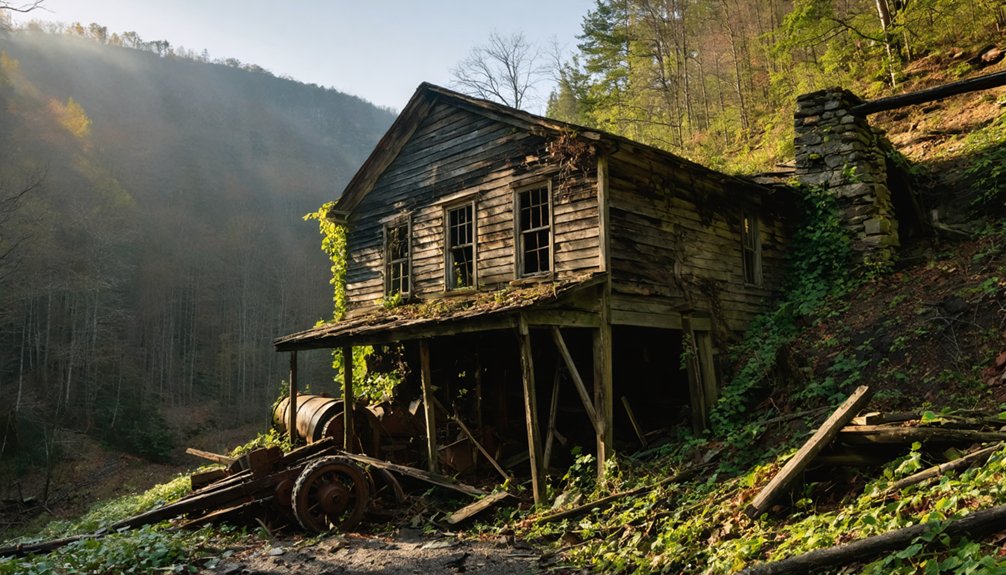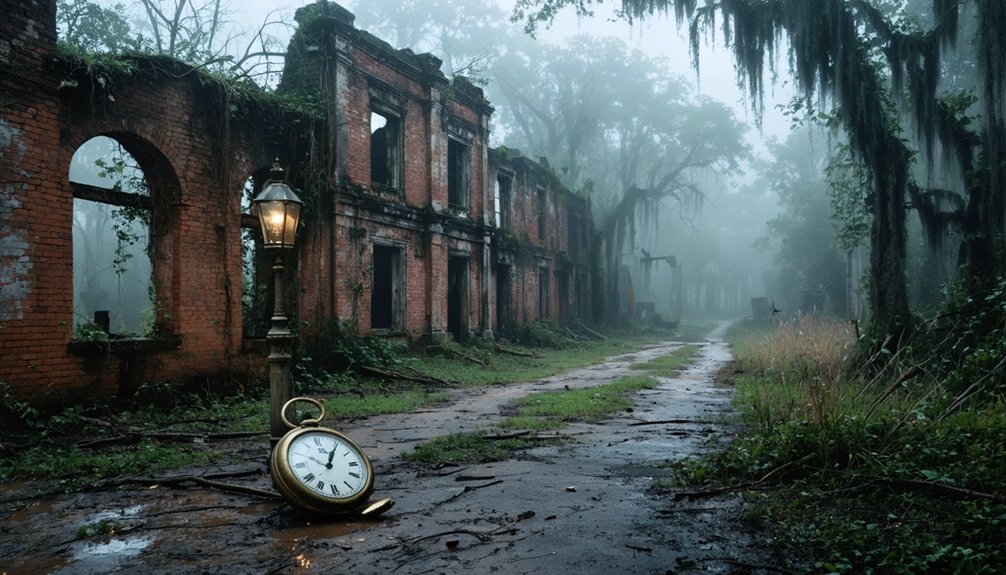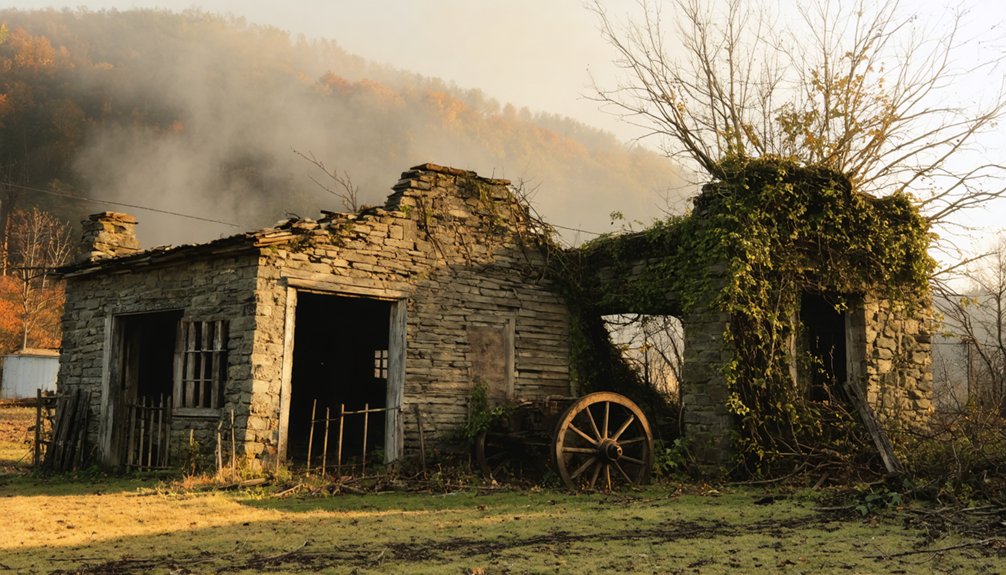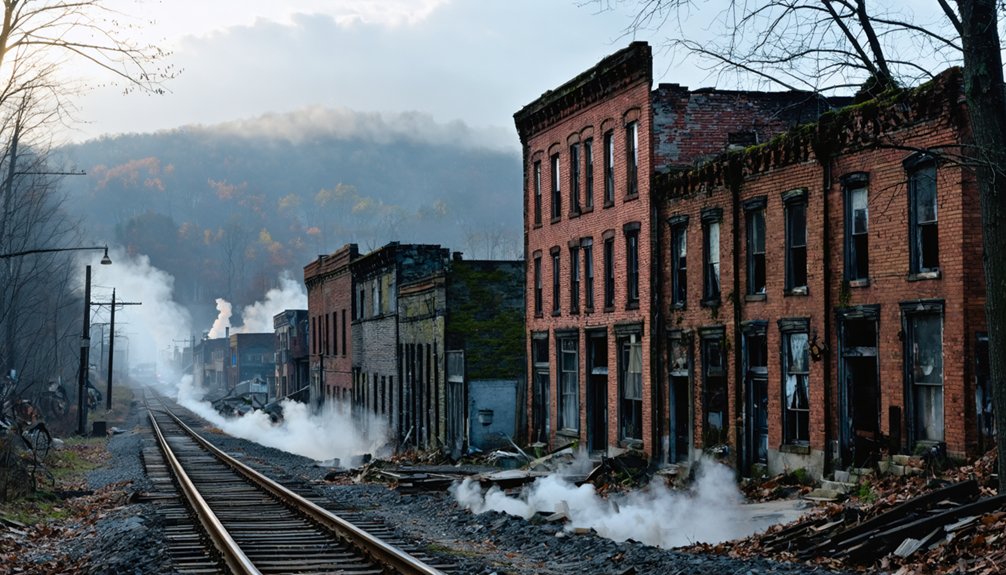Civil War era ghost towns emerged from economic collapse, shifting transportation routes, and natural disasters. You’ll find Southern settlements abandoned after cotton trade devastation, mining boomtowns that flourished briefly from wartime metal demands, and communities destroyed by floods or disease. Today, preserved sites like Bodie offer “arrested decay” glimpses into the past, while locations such as Gettysburg provide accessible ghost tours. The silent buildings hold stories waiting beyond their weathered facades.
Key Takeaways
- Civil War ghost towns emerged from economic collapse when cotton production plummeted and Union blockades eliminated 95% of Southern exports.
- Towns like Rodney, Mississippi became isolated when transportation routes shifted, causing commercial decline and eventual abandonment.
- Natural disasters including floods, fires, and disease outbreaks accelerated the abandonment of once-thriving Civil War era communities.
- Preservation efforts like Bodie’s “arrested decay” approach and Grafton’s restored schoolhouse maintain these historical sites for visitors.
- Guided tours offer historical narratives with accessibility options at sites like Gettysburg and Virginia City’s wooden boardwalk areas.
The Rise and Fall of Mining Boomtowns in the Post-War Era

While the Civil War tore the nation apart, it simultaneously catalyzed a mining boom that would transform the American West into a patchwork of hastily constructed settlements. You’d witness wilderness areas metamorphosing overnight into bustling towns as discoveries of gold, silver, and copper attracted thousands seeking mining prosperity.
Nevada’s Tonopah, Goldfield, and Rhyolite exemplify this rapid expansion around 1900.
The economic drivers were clear: surging demand for metals to supply military hardware and industrial growth. Towns like Greenwater Valley demonstrated remarkable ghost town resilience before their inevitable decline—growing to 2,000 inhabitants with $140 million in capitalization after a 1906 copper discovery. The Civil War specifically created a renewed demand for coal in regions like the Mahanoy Valley, spurring similar patterns of rapid development.
These mainly male communities faced social instability, harsh conditions, and eventual abandonment when deposits depleted or metal prices collapsed, leaving behind the skeletal remains that fascinate us today. Each discovery of valuable ore was met with shouts of bonanza as prospectors celebrated what they hoped would lead to early retirement.
Southern Ghost Towns: Casualties of Changing Economies
You’ll find numerous Southern ghost towns emerged from the devastating collapse of the cotton trade following the Civil War, when Union blockades and the subsequent loss of slave labor demolished regional economies.
Economic devastation continued as formerly prosperous commercial centers along rivers saw their significance diminish when railroads redirected trade routes away from these once-thriving communities.
The decline of ironworks industries, which had flourished during wartime production demands, further accelerated abandonment as factories closed and workers migrated to emerging industrial centers with better prospects. Disease outbreaks like yellow fever contributed significantly to population decline in places like Claiborne, where residents fled to escape deadly epidemics.
This pattern of economic upheaval was evident in Thurmond, West Virginia, where the Great Depression led to diminishing coal revenues and eventual decline as the railroad industry transitioned to diesel power.
Cotton Trade Collapse
When the Confederate leadership implemented their “King Cotton” strategy in 1861, they inadvertently set in motion economic forces that would transform vibrant Southern commercial centers into abandoned ghost towns. Their miscalculation about Britain’s dependency on Southern cotton proved catastrophic for the regional cotton economy.
The trade disruption manifested through:
- The Union Navy’s blockade of Confederate ports, which eliminated 95% of exports and prevented critically needed gold reserves.
- Cotton production’s collapse from five million bales in 1860 to merely one-quarter million by 1865.
- Britain’s successful pivot to alternative cotton sources from India, Egypt, and Brazil.
You’ll find that once-thriving trading posts along Southern waterways withered as their economic purpose vanished. Southern secessionists had believed that cotton exports would ensure economic prosperity for the Confederacy, but this strategy backfired dramatically. This economic devastation was further compounded by runaway inflation that reached an astonishing 600% by 1864, making everyday transactions nearly impossible.
What Confederate leaders imagined as leverage became instead the economic suicide of numerous commercial centers, leaving behind empty wharves and abandoned warehouses.
Post-War Economic Devastation
The Civil War’s aftermath released a second wave of destruction on Southern communities that had managed to survive the conflict itself. Towns once prosperous from river or rail commerce faced devastating economic isolation when transportation routes shifted elsewhere.
Railroad bypasses proved particularly fatal—settlements like Rodney, Mississippi lost their economic lifelines when rail companies chose alternative paths, while towns dependent on river trade watched helplessly as changing channels rendered ports useless. Rodney exemplifies this decline, transforming from a thriving river port with 4,000 residents in the 1860s to an eventual ghost town. Similar to Hennepin County’s experience, many communities fell victim to the Panic of 1857 and subsequent economic uncertainty.
Economic resilience proved impossible for communities reliant on single industries. Natural disasters—yellow fever epidemics, hurricanes, and floods—compounded these challenges, destroying infrastructure that couldn’t be rebuilt amid demographic shifts.
As populations dwindled, social institutions collapsed; schools closed, churches abandoned, and businesses relocated to emerging hubs. This post-war economic devastation transformed vibrant Southern communities into haunting reminders of prosperity lost to changing fortunes.
Ironworks Industry Decline
While Northern industrial centers rapidly adopted anthracite-based iron production, Southern ironworks faced systemic challenges that transformed them into commercial casualties of the Civil War era.
You’ll find these Southern ironworks, like the once-prominent Tredegar in Richmond, struggled with fundamental production challenges that northern competitors didn’t face.
Three critical factors sealed their fate:
- Reliance on inefficient charcoal furnaces rather than modern anthracite methods
- Devastating labor shortages from conscription of skilled workers
- Inability to access raw materials due to transportation limitations and lost supply chains
When you explore these abandoned industrial sites today, you’re witnessing the physical remnants of economic change. Tredegar’s failure to make the transition to steel production, despite employing 1,200 workers by 1873, ultimately led to its decline in national prominence.
Many communities built around these ironworks became ghost towns as facilities failed to modernize after the war, lacking capital for the shift to steel production. Tredegar Iron Works initially thrived by producing railroad spikes and artillery ordnance for government contracts before its eventual decline.
Abandoned Military Installations and Wartime Deception
You’ll find numerous Civil War era forts like Fort Moultrie and Fort Barrancas that were strategically abandoned and reoccupied throughout the conflict, illustrating tactical military deception during America’s bloodiest war.
These historic ruins remain as concrete testimonies to changing military priorities, with some installations like Fort Gorges becoming obsolete before ever being manned due to rapid advancements in artillery technology.
Military complexes such as Fort Delaware have been repurposed as living history museums, while others like Fort Schuyler transformed into educational institutions, preserving architectural innovations that once housed soldiers, prisoners, and essential defense systems.
Wartime Deception Strategies
Beneath the surface of conventional Civil War narratives lies a sophisticated network of deceptive strategies that Confederate forces employed to compensate for their material disadvantages.
You’ll find Confederate commanders were masterful practitioners of psychological warfare, using visual trickery to amplify their perceived strength against Union forces.
The South’s most effective deceptive tactics included:
- Creating “Quaker guns” from painted logs and straw dummy crewmen to simulate artillery positions
- Orchestrating repetitive troop movements in enemy sight lines, with soldiers circling back unseen
- Deliberately leaking false orders and spreading misinformation through captured soldiers
These strategies allowed smaller Confederate armies to hold strategic positions against numerically superior Union forces.
Generals like Lee and Jackson particularly excelled at creating uncertainty among Union commanders, making them hesitate to commit their forces despite overwhelming numerical advantages.
Strategic Ruins Remain
Across the American landscape, abandoned Civil War fortifications stand as silent witnesses to strategic military planning and wartime deception techniques.
You’ll find these strategic fortifications both along coastlines and inland, where they once protected crucial supply routes and transportation hubs.
Fort Sumter and Fort Pulaski represent the sophisticated coastal defenses that guarded America’s vulnerable harbors. Many were constructed using earthworks and timber for rapid deployment, while isolated installations like Fort Jefferson were positioned on remote islands for maximum tactical advantage.
As naval technology advanced, these sites became obsolete.
Today, you’ll discover crumbling gun emplacements, barracks foundations, and defensive walls slowly reclaimed by nature.
Archaeological surveys continue to uncover remnants of military hospitals and training camps, revealing the complex infrastructure that supported America’s bloodiest conflict.
Repurposed Military Complexes
While many Civil War structures have fallen into disrepair, others found new purpose through adaptive reuse initiatives that breathe fresh life into abandoned military infrastructure.
These transformations preserve military history while creating new public spaces that invite urban exploration and historical appreciation.
When visiting these repurposed complexes, you’ll discover:
- Former fortifications like Fort Tilden, once critical to New York Harbor’s defense, now offer recreational opportunities within the National Park Service.
- Previous naval installations such as Charleston Shipyard, transformed into mixed-use developments that honor maritime heritage.
- Military prisons repurposed as cultural landmarks, exemplified by Alcatraz’s evolution from military battery to tourist destination.
These adaptive reuse projects require extensive environmental remediation, particularly at sites like Fort Ord where hazardous materials necessitate ongoing monitoring.
Nature’s Role in Town Abandonment: Floods, Fires, and Disasters
When natural forces collided with the precarious foundations of Civil War era settlements, the results often proved catastrophic for community survival.
You’ll find that floods ravaged numerous towns like Linn City, Oregon, and Ben Ficklin, Texas, where the Concho River’s fury claimed over 60 lives in 1882, forcing survivors to establish communities elsewhere.
Fire devastated wooden-constructed settlements lacking adequate firefighting resources. In Garnet, Montana, the 1912 conflagration accelerated its abandonment when combined with depleted mining resources.
Environmental changes and natural disasters transformed landscapes permanently.
The 1886 earthquake in Port Royal, South Carolina, followed by hurricanes, gradually submerged portions of the town.
Meanwhile, Fort Jefferson, Florida, succumbed to hurricane damage in 1906, while droughts undermined agricultural viability across Texas communities, rendering them uninhabitable and ultimately forgotten.
Preserved Heritage: Ghost Towns as Living Museums

The transformation of Civil War era ghost towns into living museums represents one of the most successful historic preservation approaches in American heritage management.
From Bodie’s “arrested decay” preservation to Fort Jefferson’s ongoing brick fortification maintenance, these sites balance authentic historical integrity with educational access.
Archaeological preservation efforts typically follow three approaches:
- Structural stabilization, as seen in Bodie’s 110+ original buildings
- Interpretive restoration, exemplified by Grafton’s schoolhouse/church
- Curated artifact displays integrating findings from excavations at sites like Old Cahawba
These preservation models depend heavily on community engagement, with sites like Grafton hosting annual heritage festivals while Calico employs costumed interpreters.
Through ranger-led tours, living history demonstrations, and interactive exhibits, these ghost towns transform from abandoned relics into dynamic educational spaces that connect visitors with America’s complex past.
Tales From the Underground: Coal Mining Ghost Communities
Beneath America’s rural landscapes lie the haunting remnants of once-thriving coal mining communities, abandoned as subterranean resources dwindled and economic prospects collapsed.
Exploring these forgotten territories, you’ll encounter places like Centralia, Pennsylvania, where underground coal seam fires have smoldered since 1962, forcing an entire town’s evacuation.
Mining communities like Clarkville and Gallup’s “Carbon City” camps reveal distinct social structures—some featuring family-oriented facilities with schools and hospitals, while others emerged as transient work settlements.
The 1929 Wall Street Crash devastated many of these towns when companies like Lehigh Valley Coal abruptly closed multiple mines.
Today, these abandoned settlements offer fascinating glimpses into America’s industrial past.
At Eckley Miner’s Village and Kennecott, preservation efforts have transformed ghost towns into living museums that honor the experiences of coal workers and their families.
Haunted Histories: Supernatural Legends of Abandoned Settlements

Throughout America’s abandoned Civil War settlements, supernatural legends have taken root alongside historical facts, creating a ghostly tapestry that interweaves trauma, memory, and cultural mythology.
When you explore these forgotten places, you’ll encounter haunted legends that reflect a nation’s unresolved grief.
These spectral encounters typically manifest in three distinct patterns:
- Former field hospitals – Sites like Harper House in Bentonville harbor persistent spirits, with phantom lights and soldier apparitions linked to traumatic medical procedures.
- Battlefield anomalies – Locations like Devil’s Den, where severe violence occurred, produce consistent reports of ghostly snipers and artillery sounds.
- Prison camp hauntings – Cahaba, Alabama exemplifies how floating lights are interpreted as lost POW spirits seeking escape.
These phenomena represent cultural mechanisms for processing collective loss while preserving historical memory through supernatural narrative.
Planning Your Visit: Accessibility and Tours of Historic Ghost Towns
When planning a visit to Civil War era ghost towns, accessibility considerations and tour options merit careful assessment to guarantee ideal historical engagement for all visitors.
You’ll find varying levels of access at prominent locations—Bodie State Historic Park provides accessible parking and restrooms, while the Gettysburg National Military Park offers wheelchair-accessible ghost tours that illuminate Civil War history.
Most historic sites present mobility challenges due to original uneven boardwalks and terrain.
However, many visitor centers like Bodie’s seasonal facility (May-October) feature improved level landings. For accessible ghost town experiences, consider Virginia City’s wooden boardwalks or arrange drop-off services at level areas upon staff notification.
Operating hours vary seasonally, with extended summer access at most locations. Prepare for high desert conditions at elevated sites like Bodie, where weather extremes require proper planning.
Frequently Asked Questions
How Did Women’s Roles Differ in Mining Versus Agricultural Ghost Towns?
Like steel forged in fire, you’d find women in mining towns taking on direct mining occupations—prospecting, managing claims, and financing operations—while in agricultural ghost towns, they balanced traditional domestic duties with expanded agricultural responsibilities during male absences.
What Artifacts Are Commonly Found by Archaeologists in Civil War Ghost Towns?
You’ll find military remnants like artillery shells and musket parts, domestic artifacts including ceramics and pipes, structural remains like postholes, and specialized Civil artifacts such as prison-related items and historical tools from saltpeter mining.
Did Any Ghost Towns Successfully Transition to Modern Sustainable Communities?
In a miracle of resilience, you’ll find several ghost towns transformed through sustainable development and community engagement. Paxico, Langston, and Oyotunji exemplify successful transformations, preserving cultural heritage while adapting to contemporary economic realities.
How Did Racial Segregation Manifest in Civil War-Era Ghost Towns?
You’d find racial dynamics brutally enforced through segregation policies like sundown ordinances, separate facilities, exclusionary covenants, economic restrictions, and physical barriers limiting where minorities could live, work, or even travel.
What Legal Issues Surround Ownership and Preservation of Abandoned Towns?
Surprisingly, you’ll face complex land ownership challenges, including unclear titles passed through generations, alongside strict preservation regulations that limit development while protecting historical integrity of these abandoned properties.
References
- https://www.blueridgeoutdoors.com/go-outside/southern-ghost-towns/
- https://www.wideopencountry.com/the-10-eeriest-ghost-towns-in-america/
- https://www.mentalfloss.com/geography/american-ghost-towns-can-still-walk-through
- https://www.visittheusa.com/experience/5-us-ghost-towns-you-must-see
- https://www.loveexploring.com/gallerylist/131658/abandoned-in-the-usa-92-places-left-to-rot
- https://www.christywanders.com/2024/08/top-ghost-towns-for-history-buffs.html
- https://www.geotab.com/ghost-towns/
- https://en.wikipedia.org/wiki/Lists_of_ghost_towns_in_the_United_States
- https://www.youtube.com/watch?v=inRD6vYBy8M
- https://www.nps.gov/deva/learn/historyculture/perils-of-opportunity-the-mining-towns.htm



